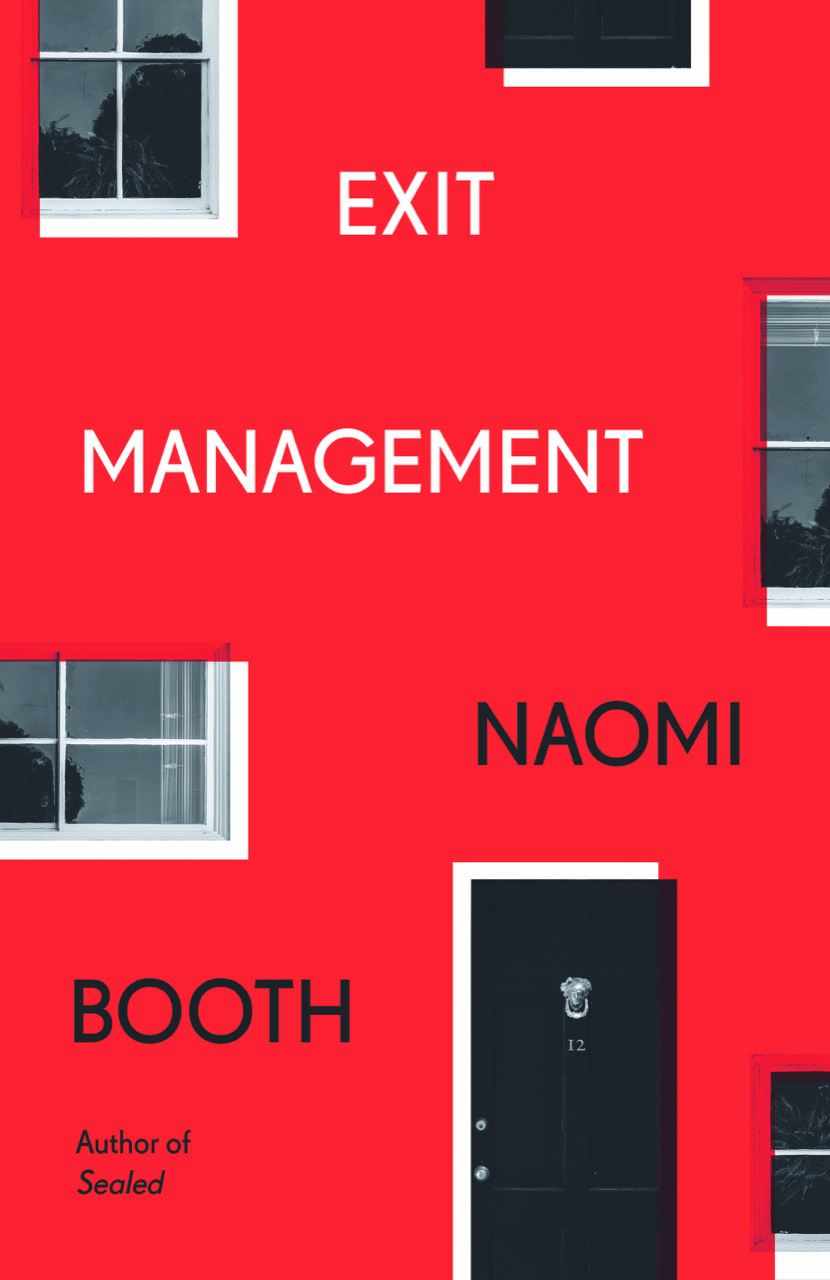Naomi Booth: Exit Management review - unwrapping life's unpleasantness | reviews, news & interviews
Naomi Booth: Exit Management review - unwrapping life's unpleasantness
Naomi Booth: Exit Management review - unwrapping life's unpleasantness
This experimental novel builds fraught atmospheres of pretence, crisis and hope

When you try to get rid of something, it comes back to bite you – so says Naomi Booth in her new novel Exit Management. It’s one of those books that you want to read very quickly, its writing slickly modern and its characters compellingly flawed. Lauren is a graduate HR employee specialising in the tricky task of making people redundant.
Both Lauren and Callum have things that they wish to push out of arm’s reach – and when they meet, in the house that Callum tends and Lauren covets, their attempts to cover up the unsavoury aspects of their lives take a new turn. Lauren is the one constantly trying to keep up the façade of perfection, down to sheering off the top layer of her skin with glycolic acid in a masochistic attempt at beautification. Moments like this have a nightmarish quality; they are done very well and echo the macabre quality of Sealed, Booth’s book before this.

But despite Lauren’s desire to eschew mess, Booth insists that life’s unpleasantness cannot be kept under wraps. The various themes of her novel – class, gender, family, race – appear disparate at first, but are woven around a series of symbols which knit them together. There is the condom that Lauren never saw come off after a sexual encounter and recurrently worries is stuck inside her. Or the memories of sexual abuse under her father’s watch that surface and resurface, even in her new life. Or the intensely physical description of the painful miscarriages she suffer
But there are also the violets that grow up between the paving stones in József’s garden, even after Lauren has tried to kill them. Sown throughout the book with references to Ophelia’s flower speech; they acknowledge sadness and loss, as well as faithfulness and growth. When, at the end of the novel, Lauren and Callum each bury the objects that remind them of the past – the things they cannot let go of – they do so in the garden of József’s beautiful house, a house Lauren has curated to perfection. Those messy, unpleasant things – that “fallen matter” – will always make up a part of the house’s identity. Similarly, Booth’s characters cannot deny such weaknesses if they wish to be genuine versions of themselves.
There is something playfully disruptive, even modernist, about Booth’s penchant for large space gaps, used to indicate pauses in the speech of her characters. This technique makes the words on the page into visual art, mirroring the colourful abstract canvases on the walls of József’s house. Just as these words constantly try to rewrite themselves, Lauren and Callum attempt to shape their own self-images, with limited success. At the end, these typeset gaps become increasingly invasive and overtake the narrative voice, exposing us to the chaos of Lauren’s own mind. The surface of the perfect life she has tried to construct for herself is shattered. But perhaps this fragmented form, which has something of the modernist stream of consciousness to it, is the only way through which the imperfect experience of life can be conveyed.
Class also plays a crucial role in this fraught atmosphere. Lauren’s childhood, which may have been inspired by Booth’s own experiences of growing up in West Yorkshire, is a world away from the shiny existence she covets and has in part achieved. This trend of unpicking class divisions and breaking down the veneer of corporate city life is popular in contemporary fiction – Naoise Dolan’s Exciting Times comes to mind. But at times, the way in which such matters are explored in Exit Management is unsubtle. Lauren’s mum is described thus: “last night’s mascara in clumps; Lycra top and trackies; very little jewellery.” Does this juxtaposition of nasty uplands against shiny South really have to be so stereotypical? Of course, the City is not as perfect as it seems – Booth admits that. But neither, perhaps, is the North wholly grim.
Despite this, Exit Management successfully covers a vast range of themes and genres, not to mention Booth’s experiments with language and typesetting. In the middle, we feel like we’re in thriller territory – but by the end, accents of hope begin to surface. Sometimes, it’s best to let the unpleasant things in. Strong symbols and compelling writing hold this novel firmly together, making it one to read now.
- Exit Management by Naomi Booth (Dead Ink Books, £9.99)
- More book reviews on theartsdesk
The future of Arts Journalism
You can stop theartsdesk.com closing!
We urgently need financing to survive. Our fundraising drive has thus far raised £49,000 but we need to reach £100,000 or we will be forced to close. Please contribute here: https://gofund.me/c3f6033d
And if you can forward this information to anyone who might assist, we’d be grateful.

Subscribe to theartsdesk.com
Thank you for continuing to read our work on theartsdesk.com. For unlimited access to every article in its entirety, including our archive of more than 15,000 pieces, we're asking for £5 per month or £40 per year. We feel it's a very good deal, and hope you do too.
To take a subscription now simply click here.
And if you're looking for that extra gift for a friend or family member, why not treat them to a theartsdesk.com gift subscription?
more Books
 'We are bowled over!' Thank you for your messages of love and support
Much-appreciated words of commendation from readers and the cultural community
'We are bowled over!' Thank you for your messages of love and support
Much-appreciated words of commendation from readers and the cultural community
 Thomas Pynchon - Shadow Ticket review - pulp diction
Thomas Pynchon's latest (and possibly last) book is fun - for a while
Thomas Pynchon - Shadow Ticket review - pulp diction
Thomas Pynchon's latest (and possibly last) book is fun - for a while
 Justin Lewis: Into the Groove review - fun and fact-filled trip through Eighties pop
Month by month journey through a decade gives insights into ordinary people’s lives
Justin Lewis: Into the Groove review - fun and fact-filled trip through Eighties pop
Month by month journey through a decade gives insights into ordinary people’s lives
 Joanna Pocock: Greyhound review - on the road again
A writer retraces her steps to furrow a deeper path through modern America
Joanna Pocock: Greyhound review - on the road again
A writer retraces her steps to furrow a deeper path through modern America
 Mark Hussey: Mrs Dalloway - Biography of a Novel review - echoes across crises
On the centenary of the work's publication an insightful book shows its prescience
Mark Hussey: Mrs Dalloway - Biography of a Novel review - echoes across crises
On the centenary of the work's publication an insightful book shows its prescience
 Frances Wilson: Electric Spark - The Enigma of Muriel Spark review - the matter of fact
Frances Wilson employs her full artistic power to keep pace with Spark’s fantastic and fugitive life
Frances Wilson: Electric Spark - The Enigma of Muriel Spark review - the matter of fact
Frances Wilson employs her full artistic power to keep pace with Spark’s fantastic and fugitive life
 Elizabeth Alker: Everything We Do is Music review - Prokofiev goes pop
A compelling journey into a surprising musical kinship
Elizabeth Alker: Everything We Do is Music review - Prokofiev goes pop
A compelling journey into a surprising musical kinship
 Natalia Ginzburg: The City and the House review - a dying art
Dick Davis renders this analogue love-letter in polyphonic English
Natalia Ginzburg: The City and the House review - a dying art
Dick Davis renders this analogue love-letter in polyphonic English
 Tom Raworth: Cancer review - truthfulness
A 'lost' book reconfirms Raworth’s legacy as one of the great lyric poets
Tom Raworth: Cancer review - truthfulness
A 'lost' book reconfirms Raworth’s legacy as one of the great lyric poets
 Ian Leslie: John and Paul - A Love Story in Songs review - help!
Ian Leslie loses himself in amateur psychology, and fatally misreads The Beatles
Ian Leslie: John and Paul - A Love Story in Songs review - help!
Ian Leslie loses himself in amateur psychology, and fatally misreads The Beatles
 Samuel Arbesman: The Magic of Code review - the spark ages
A wide-eyed take on our digital world can’t quite dispel the dangers
Samuel Arbesman: The Magic of Code review - the spark ages
A wide-eyed take on our digital world can’t quite dispel the dangers
 Zsuzsanna Gahse: Mountainish review - seeking refuge
Notes on danger and dialogue in the shadow of the Swiss Alps
Zsuzsanna Gahse: Mountainish review - seeking refuge
Notes on danger and dialogue in the shadow of the Swiss Alps

Add comment